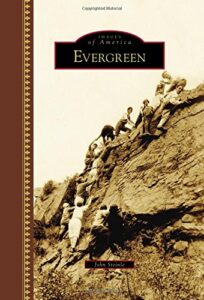
I consider Evergreen, Colorado, my “hometown,” although I’ve lived in many other places. I noticed that the author of this book, John Steinle, was the administrator of the Hiwan Homestead Museum, where my mother, Marion, was the head of the Busy Bee Quilters. The author was qualified to write the book, as he worked in Evergreen as a history education supervisor for Jefferson County Open Space for over 20 years. And I wasn’t disappointed, as the photographs in the book were taken from the comprehensive Jefferson County Historical Society Collection.
The author points out that early settlers were drawn to the Evergreen area for its unsurpassed beauty and natural resources, as would be the case for future generations. Despite the natural beauty, the author reminds us that throughout the 1860s and 1870s, a series of treaties confined the residents, the Ute people, to reservations, then took away much of the land originally granted to them until they gradually disappeared from their mountain homeland. He also reminds us that racial and religious prejudice was part of the early history, as early land deeds were restricted to “Caucasian” families, and evidence existed of Troutdale Hotel guests and staff as late as the 1940s discouraging Jewish guests from staying there.
The author uses various profiles, stories, and photos to depict the importance of ranching and lumber, the initial basis for Evergreen’s economy in the 1800s, and wealthy summer residents built prestigious second homes there. By 1920, Evergreen became a tourist mecca through the development of the Denver Mountain Parks system and famed hotels, resorts, and dude ranches.
One of the top resort destinations in Colorado was Troutdale in the Pines, on Upper Bear Creek, built in 1920. It boasted 140 guest rooms, plus 35 cabins, and its guests, which included Clark Cable and the Marx Brothers, who enjoyed a ballroom, swimming pool, bakery, and restaurant. When I passed by it in high school the resort had been abandoned.
From 1920 to 1942, Evergreen was the epicenter of outdoor recreation in Colorado. After World War II, a unique array of volunteer arts, nature, and charity organizations was created by Evergreen’s people. Explosive growth after the completion of Interstate 70 led to the development of new festivals and attractions, including the magnificent parks of the Jefferson County Open Space system, which is one of the major highlights of the area and prevented land developers from filling the hills with houses.
As I perused the book’s many historical photos and stories, I naturally filled in my own history and memories. My family moved from Denver to Kittridge, and eventually to a small horse property up Cub Creek, far from the Black Forest Inn. One of the photos was taken in 1937 with the owner, an Austrian immigrant, Edwin Welz, with Swiss costumes, which fit in with the European atmosphere that permeates the inn complex. I was part of the “bohemian era” in the 1960s and 1970s. The author depicts “artists, musicians, and hippies, including Willie Nelson,” who lived on a ranch on Upper Bear Creek.
I graduated from Evergreen High School in 1967 and was a right guard on the football team with such notables as Smokey Barnes and Tom Reese opening gaping holes for our star back, Cliff Colburn. We even practiced in a field of one of the beloved ranch families in the area, the Alderfers, – cow paddies and all.
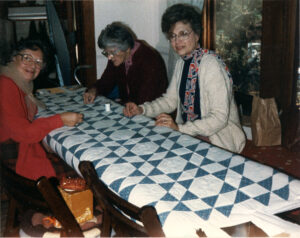
Marion is in the white sweater
My family moved to Pine Drive during my last few years in high school, which overlooked the Hiwan Homestead Museum, which the author highlights. My mother quilted there for three years, and one of her prize-winning pieces, “Evergreen 1929,” hung in the museum. Like many tourists, my family and I would visit the museum, which harkened back to years gone by.
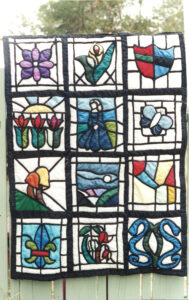
This is the “Stained Glass Quilt.” Another quilt was hung in the entry of the Church of the Hills Presbyterian Church, where we were members.
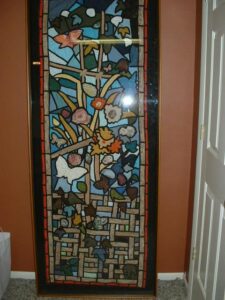
I went from Evergreen High in 1967 to Western Colorado University in Gunnison and, after four years, to the Peace Corps in Guatemala. In 1974, I returned home with a Guatemalan wife and one-year-old daughter. I forgot to mention to my new bride from the “Land of the Eternal Spring” that it was winter with two feet of snow, and everything was frozen.
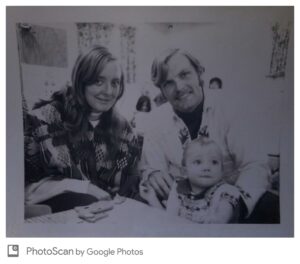
But this was an excellent opportunity to skate on Evergreen Lake and drink hot cocoa. The iconic Evergreen Lake Warming Hut was built of logs with a sod roof by Civilian Conservation Corps workers, who offered food and warmth to chilly skaters. The author tells the story of how it deteriorated in the 1990s after a fire, but would be transformed into the “crown jewel” of Evergreen. According to Steinle, the new Evergreen Lake House was completed in 1993 with a huge patio for hosting weddings, receptions, memorials, and fundraisers.
Steinle provided photos and profiles of many of the standouts and leaders of the community, such as astronaut Jeffrey Ashby, who graduated from Evergreen High School in 1972, and Linda Kirkpatrick, who published the newspaper “Upbeat” and raised funds saving Noble Meadow from development (the book was dedicated to her) and Tony Grampas, who was elected to the Colorado House of Representatives and State Senate. He was instrumental in replacing the dangerous, winding two-lane route to Evergreen with the four-lane Highway 74.
I didn’t recognize any of those highlighted by the author except fellow Returned Peace Corps Volunteers Mike and Ann Moore. They went to Togo in West Africa in the early ‘60s and were inspired by an age-old practice of mothers in Togo who breastfed and carried their children. Consequently, Ann invented, and the couple manufactured a cloth baby carrier known as “Snugli.”
I interviewed them in 2016 as a National Peace Corps Association consultant to support their “Community Fund” planning study. The Moores were involved with many charities and local civic groups, including the Evergreen Rotary Club, where Ann was an active member. Their lovely home overlooked Kerr Gulch, bringing back other memories I don’t have time to tell here.
A photo of “El Rancho, Colorado” brought back reminiscences of the log restaurant built by the Jahnke family in 1948, using the second floor as their home. When I-70 was completed, El Rancho became the only restaurant in the United States with a highway exit named after it. I was a lowly dishwasher in high school, although I eventually worked as an assistant cook at the Hiwan Country Club. El Rancho is now a brewpub with a view!
The photo of “Keys on the Green” reminded me of the many times we took my mother to lunch there. Marion enjoyed the quaint eatery with friendly staff and excellent food, and we all appreciated the view of the golf course, with the lake in the distance and elk lounging in the grass next to the parking lot. The author says it was built in the 1920s, but expanded in the 1980s as the golf clubhouse by Denver Broncos running back Jon Keyworth.
Evergreen, like where I live today, Scottsdale, Arizona, still retains an atmosphere of the legendary Old West. In Evergreen’s case, this includes its boardwalk along Main Street with the iconic Little Bear Saloon, its annual Evergreen Rodeo, and Rodeo Parade to its surviving area ranches. Although my parents have passed, I still look forward to visiting this scenic community in the foothills.
This book is part of a collection of local history books featuring millions of vintage images: www.arcadiapublishing.com. I found some 284 books on their website about Colorado, including Conifer.
About the Author
John Steinle, a native of Hamilton, Ohio, received a master’s degree in museum and archival management from Wright State University. Steinle was a curator and archivist at the Cincinnati Art Museum and Cincinnati Historical Society and was a director at several Ohio museums before moving to Colorado in 1992. In 1994, he became the administrator of the Hiwan Homestead Museum in Evergreen, Colorado, working for Jefferson County Open Space. He was later promoted to the Bear Creek Region’s history education supervisor and region supervisor. He retired in 2016. His new book, Colorado in the Civil War, just came out.
Product details
- Publisher : Arcadia Publishing (August 28, 2017)
- Language : English
- Hardcover : 128 pages
- ISBN-10 : 146712611X
- ISBN-13 : 978-1467126113
- Item Weight : 01 pounds
- Dimensions : 5 x 0.31 x 9.25 inches
- Best Sellers Rank: #1,084,384 in Books (See Top 100 in Books)
- #61 in Skiing Travel Guides
- #62 in Denver, Colorado Travel Books
- #1,445 in West Mountain United States Travel Books
- Customer Reviews:
5.0 5.0 out of 5 stars 8 ratings
About the Reviewer
Walker was a Peace Corps Volunteer in Guatemala, spending over forty years helping disadvantaged people in the developing world with organizations like CARE, PLAN, and MAP International, and the CEO of Hagar USA. His memoir, Different Latitudes: My Life in the Peace Corps and Beyond, his first book, was followed by My Saddest Pleasures: 50 Years on the Road.
He’s a contributing writer for The Authors Show, Revue Magazine, Literary Traveler, and the Wanderlust Journal. His “The Million Mile Walker Review: What We’re Reading and Why” is part of the Arizona Authors Association Newsletter. One of his 28 articles was awarded a “Bronze” by the Solas Literary Award for Adventure Travel Writing. He founded Million Mile Walker LLC in 2016. His wife and three children were born in Guatemala. He can be found at www.MillionMileWalker.com
Thanks to Mark Walker class of 67’s historian . Colorful description of our era in Evergreen .